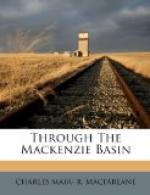“Here it was,” Mr. McKenna writes me, “that the chief asked for a railway—the first time in the history of Canada that the red man demanded as a condition of cession that steel should be laid into his country. He evidently understood the transportation question, for a railway, he said, by bringing them into closer connection with the market, would enhance the value of what they had to sell, and decrease the cost of what they had to buy. He had a striking object-lesson in the fact that flour was $12 a sack at the Fort. These Chipewyans lost no time in flowery oratory, but came at once to business, and kept us, myself in particular, on tenterhooks for two hours. I never felt so relieved as when the rain of questions ended, and, satisfied by our answers, they acquiesced in the cession.”
Next morning these Commissioners left for Smith’s Landing, and, on the 17th, made treaty with the Indians of Great Slave Lake. Meanwhile Mr. Laird had proceeded to Fond du Lac, at the eastern end of Lake Athabasca, and there, on the 27th, the Chipewyans adhered, whilst Messrs. Ross and McKenna, in order to treat with the Indians at Fort McMurray and Wahpooskow, separated. The latter secured the Chipewyans and Crees at the former post, and Mr. Ross the Crees at Wahpooskow, both adjustments, by a coincidence, being made on the same day.
This completed the Treaty of 1899, known as No. 8, the most important of all since the Great Treaty of 1876.
The work of the Commission being now over, its members prepared to leave the country. Messrs. Ross and McKenna set out for Athabasca Landing, whilst Mr. Laird accompanied us to Pelican Rapids, but left us there and pushed on, like the others, for home.
There were, of course, many Indians who did not or could not turn up at the various treaty points that year, viz., the Beavers of St. John, the Crees of Sturgeon Lake, the Slaves of Hay River, who should have come to Vermilion, and the Dog-Ribs, Yellow-Knives, Slaves, and Chipewyans, who should have been treated with at Fort Resolution, on Great Slave Lake.
Accordingly, a special commission was issued to Mr. J. A. Macrae, of the Indian Office in Ottawa, who met the Indians the following year at the points named, and in May, June, and July, secured the adhesion of over 1,200 souls, making, with subsequent adhesions, a total of 3,568 souls to the 30th June, 1906.
The largest numbers were at Forts Resolution, Vermilion, Fond du Lac, and Lesser Slave Lake, the latter ranking fourth in the list. Of course, there are still to be treated with the Indians of the Mackenzie River and the Esquimaux of the Arctic coast. But Treaty Eight covers the most valuable portions of the Northern Anticlinal, though this is a conjecture, as the resources of the lower Mackenzie Basin, and even of the Barren Lands, are only now becoming known, and may yet prove to be of great value. Bishop Grouard told me that at their Mission at Fort Providence, potatoes,




